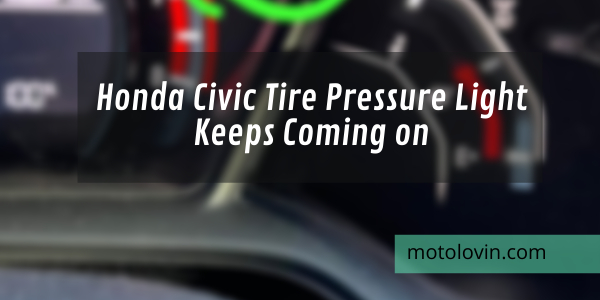If your Honda Civic tire pressure light keeps coming on, it may indicate low tire pressure or a faulty tire pressure sensor. Properly inflated tires and checking for any damage to the sensors are important first steps to troubleshooting this issue.
Driving with low tire pressure can lead to decreased fuel efficiency, poor handling, and increased risk of tire failure. It’s crucial to address the issue promptly to ensure safe and efficient driving. We’ll explore some common reasons why the tire pressure light in your Honda Civic keeps illuminating and provide practical solutions to resolve the problem.
By following these steps, you can ensure your Honda Civic is safe and operating at its best.
Common Causes Of Tire Pressure Light
| Common Causes of Tire Pressure Light |
|---|
Discovering why your Honda Civic’s tire pressure light keeps coming on is vital for maintenance.
Underinflated Tires
One of the most common reasons for the tire pressure light is having underinflated tires.
Low tire pressure can be caused by changes in weather or driving over rough surfaces.
Faulty Tire Pressure Monitoring System
Another possible cause for the persistent light could be a faulty Tire Pressure Monitoring System.
This system helps alert you to low tire pressure for safety reasons.

Credit: www.reddit.com
Importance Of Proper Tire Pressure
Proper tire pressure is crucial for maintaining the safety and performance of your Honda Civic.
Ensures Vehicle Safety
Maintaining the correct tire pressure reduces the risk of accidents due to tire blowouts.
Optimizes Fuel Efficiency
Proper tire pressure helps in maximizing your Honda Civic’s fuel efficiency.
How To Check Tire Pressure
To check the tire pressure on your Honda Civic and address the recurring tire pressure light, follow these steps: 1. Locate the recommended tire pressure in your vehicle’s manual or on the driver’s side door jamb. 2. Use a tire pressure gauge to measure the pressure in each tire.
3. If the pressure is low, add air until it reaches the recommended level. Avoid overinflating. 4. Repeat this process regularly to maintain proper tire pressure and prevent the light from coming on.
Checking your Honda Civic’s tire pressure regularly is crucial for maintaining optimal performance and safety. If you’ve been dealing with the frustrating issue of the tire pressure light constantly coming on, it’s time to take matters into your own hands. In this section, we will explore two simple and effective ways to check your tire pressure: using a tire pressure gauge and referring to the vehicle’s manual.
Using A Tire Pressure Gauge
Using a tire pressure gauge is an easy and accurate method to check your Honda Civic’s tire pressure. This handheld device provides a precise reading of the pressure within each tire, allowing you to make necessary adjustments as required. Here’s a step-by-step guide on how to use a tire pressure gauge:
- Park your Honda Civic on a flat surface and engage the parking brake for added safety.
- Locate the valve stem on one of the tires. This is usually a small, protruding, cylindrical object.
- Remove the cap from the valve stem by twisting it counterclockwise.
- Take the tire pressure gauge and press the end onto the valve stem firmly. You should hear a small release of air.
- Read the tire pressure display on the gauge. It will provide a measurement in PSI (pounds per square inch).
- Compare the measured tire pressure with the recommended pressure specified in your Honda Civic’s user manual.
- If the measured pressure is lower than the recommended level, use an air compressor to inflate the tire. If it’s higher, release some air using the gauge or a suitable tool.
- Repeat these steps for each tire, ensuring they are all properly inflated.
- Once you’ve checked and adjusted the tire pressure, replace the valve stem caps by twisting them clockwise.
Checking The Vehicle’s Manual
Another reliable source for checking your Honda Civic’s recommended tire pressure is the vehicle’s manual. The manual provides specific guidelines based on the make, model, and year of your Civic. To find the recommended tire pressure:
- Locate your Honda Civic’s manual either in the glove compartment or online.
- Refer to the index or table of contents to find the section related to tire pressure.
- Once you’ve located the section, identify the recommended tire pressure values for your Civic.
- Use a tire pressure gauge to measure the current tire pressure, as explained in the previous section.
- Compare the measured pressure with the recommended values from the manual.
- If adjustments are necessary, follow the steps outlined earlier to inflate or release air accordingly.
By regularly checking and maintaining the proper tire pressure, you can not only keep the annoying tire pressure light from reappearing but also enhance the fuel efficiency, handling, and overall longevity of your Honda Civic. Remember, it’s always better to be proactive and address tire pressure issues promptly.
Steps To Reset The Tire Pressure Light
If your Honda Civic’s tire pressure light continues to come on despite having proper tire inflation, you may need to reset the tire pressure monitoring system. Follow these simple steps to reset the tire pressure light and ensure your vehicle’s safety and performance.
Check Tires For Proper Inflation
Start by checking each tire’s pressure using a reliable tire pressure gauge. Ensure that the pressure matches the recommended levels specified in your Honda Civic’s manual. If any tire is under or overinflated, adjust the pressure accordingly.
Locate The Tire Pressure Reset Button
Find the tire pressure reset button, usually located under the steering wheel or inside the glove compartment. Refer to your Honda Civic’s manual if you are unable to locate it. Once found, ensure the vehicle is in the parked or idle position and the ignition is turned on.
When To Seek Professional Assistance
If you find that your Honda Civic’s tire pressure light keeps coming on despite your best efforts, it may be time to consider seeking professional assistance. Addressing persistent issues with the tire pressure system is crucial to ensure your safety on the road.
Persistent Tire Pressure Light
If the tire pressure light in your Honda Civic continues to illuminate even after you have addressed the tire pressure, it is essential to consult a professional. Persistent occurrences could indicate an underlying issue that requires skilled attention to diagnose and resolve.
Uncertain About Correct Inflation
If you are uncertain about the correct inflation pressure for your Honda Civic’s tires, seeking professional assistance can provide peace of mind. A qualified technician can accurately determine the proper tire pressure and ensure that your vehicle is operating safely and efficiently.

Credit: www.reddit.com

Credit: www.bianchihonda.com
Frequently Asked Questions For Honda Civic Tire Pressure Light Keeps Coming On
What Is The Ideal Tire Pressure For A Honda Civic?
Maintain 32 to 35 psi for optimal performance.
How Often Should I Check The Tire Pressure In My Honda Civic?
Check every month, especially before long trips.
What Could Be Causing The Tire Pressure Light To Come On Frequently?
Possible reasons include temperature changes, leaks, or faulty sensors. Regular checks are necessary.
How Can I Reset The Tire Pressure Light In My Honda Civic?
Consult the owner’s manual for specific instructions or visit a mechanic. . .
Conclusion
It’s crucial to address the Honda Civic tire pressure light issue promptly to ensure optimal safety and performance. By regularly checking and adjusting tire pressure, you can prevent potential hazards on the road. If the light continues to illuminate, consult a professional or refer to the vehicle’s manual for specific instructions.
Proper maintenance will not only enhance your driving experience but also prolong the life of your tires.
